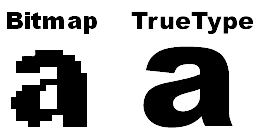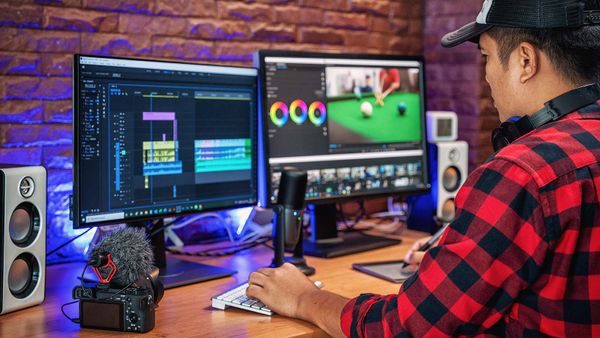If you are sitting at a Windows or Macintosh computer right now, then you are looking at a TrueType font as you read this! Fonts are the different styles of typefaces used by a computer to display text. If you are like most people, you are probably looking at text in many different sizes and you may even want to print out a document. Early computer operating systems relied on bitmapped fonts for display and printing. These fonts had to be individually created for display at each particular size desired. If you made the font larger or smaller than it was intended to be, it looked horrible. And printed text was almost always very jagged looking.
In the late 1980s, Adobe introduced its Type 1 fonts based on vector graphics. Unlike bitmapped fonts, vector fonts could be made larger or smaller (scaling) and still look good. Adobe also developed a printing language called Postscript that was vastly superior to anything else on the market. Microsoft and Apple were very interested in these technologies but did not want to pay royalties to Adobe for something that could become an integral part of both companies' operating systems. For that reason, Microsoft and Apple joined to develop vector font and printing technology of their own. In the end, Apple actually developed the font technology, TrueType. Meanwhile, the print engine being developed by Microsoft, TrueImage, never really got off the ground.
Advertisement
TrueType technology actually involves two parts:
- The TrueType Rasterizer
- TrueType fonts
The Rasterizer is a piece of software that is embedded in both Windows and Mac operating systems. It gathers information on the size, color, orientation and location of all the TrueType fonts displayed and converts that information into a bitmap that can be understood by the graphics card and monitor. It is essentially an interpreter that understands the mathematical data supplied by the font and translates it into a form that the video display can render.
The fonts themselves contain data that describes the outline of each character in the typeface. Higher quality fonts also contain hinting codes. Hinting is a process that makes a font that has been scaled down to a small size look its best. Instead of simply relying on the vector outline, the hinting codes ensure that the characters line up well with the pixels so that the font looks as smooth and legible as possible.
There are literally thousands of TrueType fonts available, many of them for free on the Web. A lot of these fonts have simply been scanned and converted from other sources. While most fonts should be perfectly fine, an improperly created TrueType font can include errors that could potentially crash your computer. Professionally designed fonts can cost a hundred dollars apiece but usually are heavily hinted and have been tested at a variety of sizes and angles for optimum quality. These features are important for advertising firms and publishing houses. For most of us, the free or inexpensive fonts work just fine.
To learn more, check out the interesting links on the next page.
Advertisement


